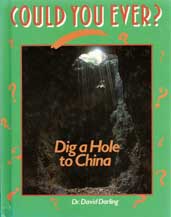COULD YOU EVER DIG A HOLE TO CHINA?: 5. Journey to the Center of the Earth
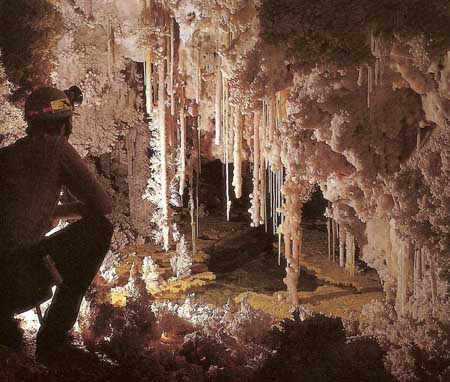
Figure 1. Inside Carlsbad Caverns.
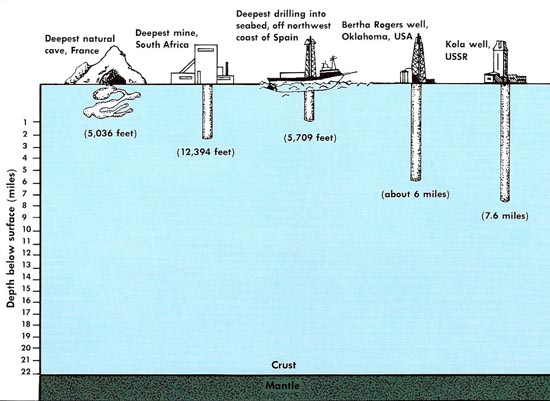
Figure 2. In 1960, the bathyscaphe Trieste carried two scientists to the bottom of the Challenger Deep, the deepest known point in the ocean. It took the Trieste nearly five hours to reach the bottom.
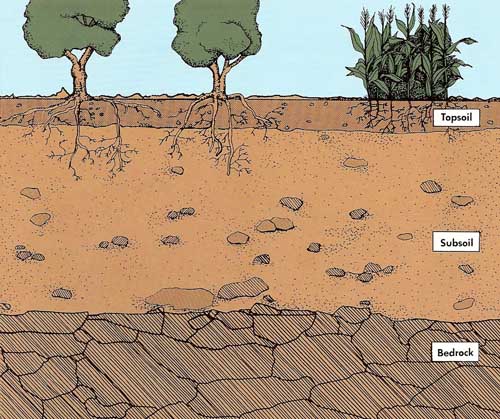
Figure 3. The topsoil, subsoil, and bedrock are the uppermost layers of the Earth's crust.
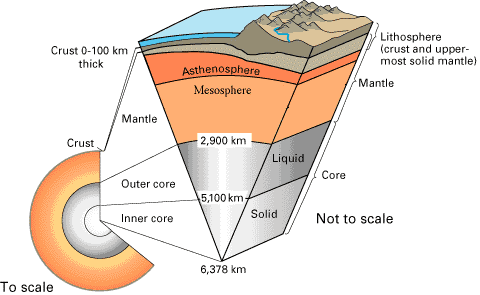
Figure 4. Moving from the crust to the mantle to the core, pressures and temperatures increase to very high levels.
It seems odd that a place only 4,000 miles away should be so hard to reach. After all, human beings have landed on the Moon, which lies at an average distance of 238,000 miles from the Earth. Robot space probes have traveled even farther – past planets that are hundreds of millions of miles away.
Yet a point that is nearer to us than New York is to Moscow – the center of the Earth – seems hopelessly beyond our reach? Why is it so difficult to get there?
Pressure and Temperature
Just as it does in the sea, the pressure – the force acting on a given area – increases with depth. This occurs because of the increasing weight of the material pressing down from above. But the rocks in the Earth's crust are about three times as dense as water. Underground, then, the pressure rises three times as quickly as it does in the sea.
Specially built deep-sea submarines called bathyscaphes have descended to the deepest point in the ocean, about seven miles beneath the surface. Here, in a Pacific Ocean canyon called the Challenger Deep, these vessels experience a pressure of more than 7 tons per square inch. Without steel walls nearly five inches thick, they would be crushed. Yet that same enormous pressure is exerted on rocks just two miles beneath the Earth's surface. At the center of the Earth, scientists believe that the pressure may be more than 20,000 tons per square inch. That is like having about a million elephants balancing on top of your head!
To add to the problems of exploring deep underground, the temperature also increases with depth. Near the base of the crust, it may be as hot as 1,100°F. In the mantle, the temperature rises to 6,330°F. In the inner core it may reach 11,400°F.
Given these extremes of heat and pressure, it is hard to imagine any human-carrying vehicle that explore far below the surface. A device like a large tunnel-boring machine, built to carry people, might be able to bore down to a depth of a few miles. It is possible that such a craft could one day explore the roots of the Himalayan Mountains. It may also be used to search for valuable minerals under the Pacific Ocean bottom. But no vehicle with a human pilot could be made strong enough to withstand the immense pressures and temperatures of the mantle or the core.
Perhaps in the future, an advanced automatic probe, controlled from the surface, could penetrate deep within the Earth. But it would have to be constructed of materials as yet unknown. The probe would also need to be completely solid. If it had any spaces inside, it would be crushed by the extreme pressures deep inside the Earth.
The idea of building a tunnel to the center of the Earth may always remain an impossible dream. To begin with, parts of the mantle and the core contain liquid rocks that would flow into any passage that was made through them. But even if we cannot actually dig our way to China, at least we can try to imagine what such a journey would be like.
The Mountains of the Core
After studying the way earthquake waves bounce off or pass through the Earth's core, some American scientists have reached a surprising conclusion. The core of our planet, they say, may not be perfectly round. It seems to have bumps, or mountains, as much as 6 miles high under places such as eastern Australia, the central North Atlantic Ocean, and the northeast Pacific Ocean. Valleys of similar size have been detected beneath Europe, the East Indies, and the southwest Pacific Ocean. The way in which liquid rocks in the core "slosh" against these strange mountains and valleys, claim the scientists, could account for tiny changes in the length of our day. This has been known to vary as much as five hundred millionths of a second over the span of a decade.
Into the Unknown
Armed with spades, pickaxes, and a mountain of other gear, you and your team begin the great project. Having chosen your site, you first dig away the topsoil. This is the fine, crumbly earth in which plants grow and worms and other creatures make their underground homes. Then you descend through the subsoil, a more stony layer, to the top of the bedrock, the solid surface of the crust. That completes the easy part of the work!
With pickaxes and drills, your tireless team starts to break up the bedrock inch by inch, hoisting the pieces of rock out of the hole in a bucket. The sides of the hole now begin to reveal the ancient history of the Earth in this area. A layer of limestone, containing fossil shells and coral, shows that this place was once covered by a shallow sea. The deeper you go, the older the rocks become. Eventually, the hole reaches down to a mass of granite more than 3 billion years old. At this time in history, only the simplest form of life existed on the planet.
Day by day, week by week, the hole gets deeper and hotter. Already it is more than 100°F and rising. From now on, your team is superhuman, able to survive temperatures that will climb higher than those of any oven.
The hole reaches a depth of 18½ miles, having passed through solid granite for most of that distance. But now a message comes from the bottom that the rock has changed to basalt. This is the last major layer before the boundary with the mantle! Encouraged, the team works at a faster pace. At a depth of 31 miles, cheers come over the radio from the working group. The hole has reached the so-called M-discontinuity, the junction between the crust and the mantle. At last, you are ready to explore completely uncharted territory.
The going now gets much tougher for a while as your team has to dig through molten rock at the top of the mantle. Temperatures are extremely high – as hot as 2,700°F. As the hole continues down, the mantle rocks become stiffer due to the huge pressure bearing down on them. The rock itself is heavy and dark in color. It may include peridotite, olivine, and perovskite. These are all minerals that are made mainly of metals, silicon, and oxygen. The deeper the hole grows, the denser and hotter these substances become.
Now the hole is 1,800 miles deep, and the temperature is more than 6,000°F. You have come to the edge of the Earth's core! Under incredibly high pressure, liquid iron mixed with smaller amounts of other metals such as nickel move slowly through the upper part of the core. These moving currents of iron give rise to the Earth's magnetic field – the force that acts on compass needles.
Finally, with the temperature more than 8,000°F, your hole plunges into the inner core. Here, the core contains mostly solid iron. Like Jules Verne's explorers, you have reached the very center of the Earth. From now on the hole continues upward. It passes through the various layers of the Earth in reverse, until you emerge again in China on the opposite side of the world!
Questions for the Future
No one knows yet the exact substances or conditions that exist deep inside our planet. For example, recent research suggests that the temperature of the Earth's core might be almost twice as high as most scientists previously thought. The chemical makeup of the mantle also remains uncertain.
Some of this missing knowledge will be gained from listening with more sensitive equipment to the shock waves produced by earthquakes and human-made explosions. Some of it will come from laboratory tests in which scientists study how different substances react to extreme pressures and temperatures. And most exciting of all, it may be possible to bring back samples of the deep interior of the Earth by drilling or boring through the crust. Scientists believe this may be achieved by the near future. That would at least be a first step on the way to China.

